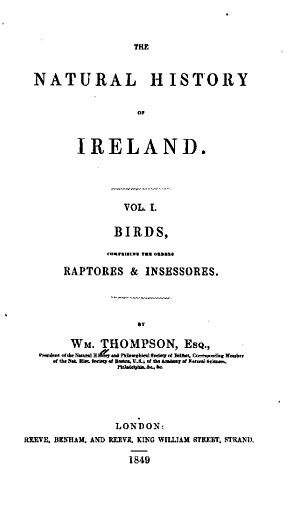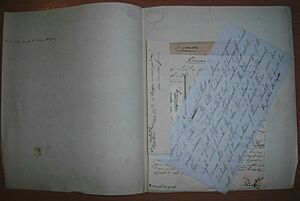The Natural History of Ireland facts for kids
The Natural History of Ireland is a big, four-part book series written by William Thompson. The first three books came out between 1849 and 1851 in London. The fourth book was published in 1856, a few years after Thompson passed away. This important series was the very first time someone tried to write a complete guide to all the animals living in Ireland.
Thompson believed that every country should have its own special book about its natural history. Before his work, information about Irish birds and animals was only briefly mentioned in other books about British wildlife.
Contents
What's Inside the Books?
The series is divided into four volumes, each focusing on different types of animals:
- Volume 1 (1849): All about Birds, specifically birds of prey (like eagles) and perching birds (like sparrows).
- Volume 2 (1850): More about Birds, including ground-feeding birds (like chickens) and wading birds (like herons).
- Volume 3 (1851): Even more about Birds, this time focusing on swimming birds (like ducks and swans).
- Volume 4 (1856): This final book covers Mammals, Reptiles, and Fishes. It also includes Invertebrates (animals without backbones, like insects and worms). This volume was finished and published by George Dickie, James Ramsey Garrett, and Robert Patterson after Thompson's death.
How Thompson Gathered Information
Thompson was very interested in birds. He used his own observations, which he had sometimes published before. He also included information from other British writers and many people he wrote to across Ireland. People like William Sinclaire, a bird collector, and John Vandeleur Stewart helped him a lot.
Thompson also looked at animal specimens kept in museums. He visited the Belfast Museum, the Dublin University Museum, and the Royal Dublin Society Museum. He often mentioned "bird preservers," who were people skilled in taxidermy, preparing animals to be studied.
Early Animal Lists for Ireland
Before Thompson's big work, in 1837, a scientist named Robert Templeton published a paper called "Irish Vertebrate Animals." This was the first scientific list of birds, mammals, and fish found in Ireland. Thompson built on this earlier work.
How Animals Were Grouped
In Thompson's time, scientists used different ways to group animals. For example, birds were placed into categories like:
- Raptores: This group included birds of prey, like falcons and owls.
- Insessores: This was a term for birds with feet made for perching on branches.
- Rasores: This group included ground-feeding birds, similar to chickens.
- Grallatores: This term was used for all wading birds, like cranes and herons.
- Natatores: This group included all swimming birds, such as ducks, geese, and swans.
Why No Pictures?
Thompson's books do not have any illustrations. He explained that pictures of Irish birds weren't needed because many other British bird books already had them. He mentioned famous works by Selby, Gould, Bewick, and Yarrell. These books already showed colored pictures of many of the birds found in Ireland.
A Story from the Book: The Great Spotted Cuckoo
The book is written in a detailed and interesting way. For example, on page 364, Thompson tells the story of a rare bird called the Great Spotted Cuckoo:
A letter from A. Crighton, Esq., from Clifden, Connemara, shared this information: "A cuckoo, being chased by hawks, was caught by two people on Omagh island. It flew into a hole in a stone wall, was caught alive, and lived for four days on potatoes and water. The local people had never seen a bird like it before. The bird seemed tired and weak, as if it had flown a very long way, just like other migrating birds do when they first arrive."
This happened in March 1842. The bird was sent to Dublin to be preserved. A beautiful drawing of it was made by Miss Battersby. This cuckoo was the only one ever known to have visited the British Islands at that time! Thompson also noted that this type of cuckoo usually lives in North Africa and sometimes visits southern Europe.
Working on Volume 4: Invertebrates
For the fourth volume, which covered invertebrates (animals without backbones), the editors got help from many people. Robert Ball in Dublin and George Crawford Hyndman in Belfast had already given Thompson information about invertebrates. Alexander Henry Haliday wrote a short part about insects, listing how many Irish species were in each group. Other important contributors included William Henry Harvey, George James Allman, and Joshua Alder.
This section also used information from Robert Templeton's earlier work from 1836, which listed many annelid (worm-like) and rayed animals found in Ireland. Two women also contributed to this volume: Miss Hancock (sister of Albany Hancock) and Mary Ball.
Thompson's Amazing Method
William Thompson had a very organized way of keeping his notes for The Natural History of Ireland. He used envelopes to store everything!
He had small envelopes for notes on individual animal species. These small envelopes were then placed inside larger envelopes for different genera (groups of similar species). These larger envelopes were then put into even bigger envelopes for families (even larger groups of animals).
He arranged all these envelopes in a specific order, so he could quickly find any animal he needed. His notes were written on all sorts of paper, sometimes even tiny scraps, showing how dedicated he was to his research!
Images for kids




